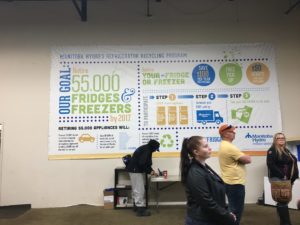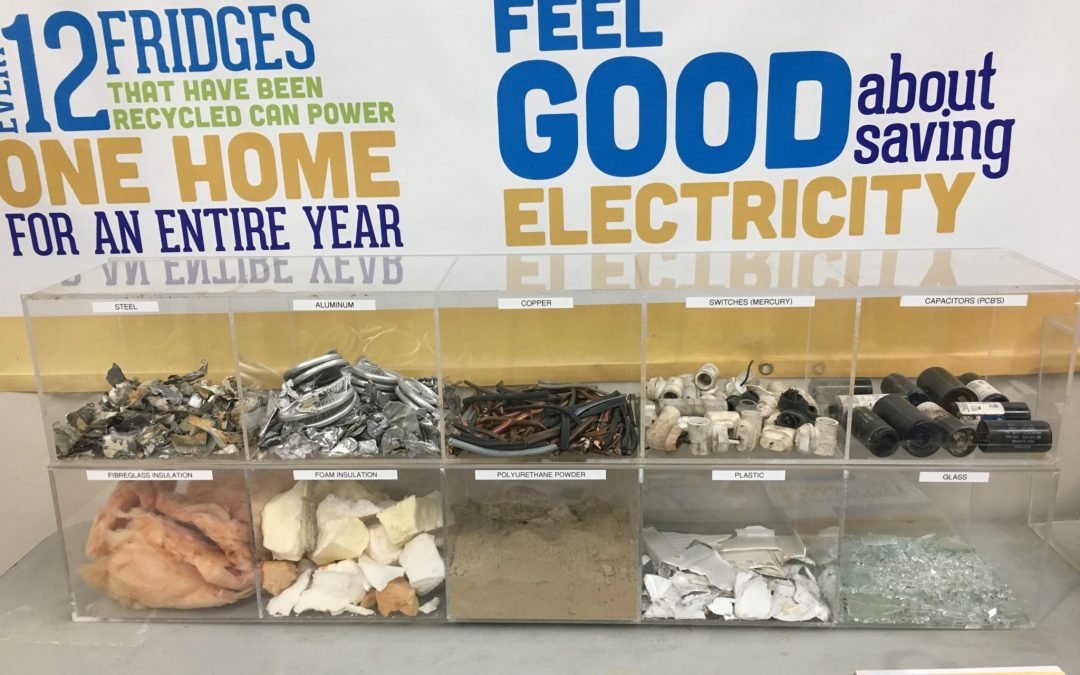“White goods” is an odd phrase coming from the historical fact that most refrigerators, air conditioners, stoves, and similar durable consumer appliances, used to be universally painted with a white enamel finish. You can get them in all kinds of colours and finishes today, but they still get called “white goods”! Sometimes lighter electronic consumer products (TVs, radios, computers, etc) get called “brown goods”, though typically today in waste management we call these “e-waste” when they’re at the end of their lifespan. Let’s pull apart the white goods category and learn what to do with them at the end of their usable lifespan.
In 2014, 348,528 tonnes of white goods were diverted from the landfill in Canada! Unfortunately, many many more are still ending up in the landfill every year. Not only are they bulky and take up a lot of space, but they contain many valuable as well as polluting materials.
Hazards in White Goods
Depending on the age of your white goods, many contain switches that are mercury-containing. This persistent pollutant gets into our waterways easily, and bioaccumulates – meaning that organisms higher up the food chain end up with high concentrations of it when they consume many smaller organisms that have contacted mercury.
If your white goods date back to the 1980s (and how many of us still have an old clunker of a fridge or freezer from that era still chugging along?), it may well have been insulated with asbestos. While asbestos is not harmful if left undisturbed, in a landfill it may eventually become exposed and a hazard. Any white goods with asbestos should be dealt with by a properly certified facility.
Refrigerants, found in air conditioners, refrigerators, freezers, and a few other types of appliance. You may have heard them referred to as CFC, HCFC, and HFCs – all just acronyms for the type of chemical compound they are. CFCs are the type that contribute to thinning in the ozone layer (which protects us from harmful UV radiation), and the other two (HCFCs and HFCs) do less damage to the ozone layer but are very powerful greenhouse gases. There are a few other refrigerants out there, such as Ammonia, HFs, and CFs, but they are much less commonly used.
The Hidden Challenge

Sliced foam-insulated walls of refrigerators and freezers set aside for gas extraction and recycling.
Those of us who do our best to Refuse, Reduce, Reuse, Repair, and Recycle, may already be all over trying to bring our old fridge to someplace other than the dump. But did you know that it’s not just the refrigerants you need to be sure are dealt with responsibly? Modern fridges and freezers have a type of expanded foam in them that contains, in the little air bubble pockets, highly potent greenhouse gases. In fact, this insulating foam can contain MORE greenhouses gases in total than in the tubes that keep the whole thing feeling nice and chilly! Fortunately, there’s at least one company in Manitoba that extracts these gases and disposes of them responsibly.
How to Recycle White Goods
In Manitoba, there’s a few options for White Goods recycling. As with much of waste management, your options may be more limited if you live in a rural or northern community, but don’t be afraid to check! The Provincial Government’s Waste Wise portal is a really helpful place to start if you want to know where to bring a wide range of goods for safe disposal.
If your fridge or freezer still works and is at least 15 years old, Manitoba Hydro’s Power Smart Retire Your Fridge program may be for you. Find out if you’re eligible here. Hydro will pick up the fridge or freezer and give you $50 as a reward for cutting back on your power usage! However, we would add a caution: you’re probably not helping the environment if you retire your fridge just to replace it with a brand-new model, because the creation of the appliance has a large environmental cost to it on top of the electricity used to run it. But if you’re just retiring that second fridge, go for it! If your fridge still works and is less than 7 years old, consider donating it to the Habitat for Humanity Re-Store. Please call (204) 233-5160 for more information.

Last year, the Retire My Fridge program exceeded 55,000 fridges & freezers retired and responsibly recycled.
The Retire Your Fridge program brings everything to an excellent business called PureSphera, which recycles all the metal and glass, extracts the gases from the refrigeration unit, and makes sure that all the gases from insulation are properly captured. They recycle just about anything attached to your household appliances that could be recycled! The great news is that even if your appliance doesn’t qualify under the PowerSmart program, you can still hire them to pick up your white goods – or drop it off yourself for free. The only catch is that unless you’re in a municipality that has partnered with PureSphera, you will have to be close enough to their Winnipeg facility to make this viable. PureSphera will accept just about any household appliance you can think of, and if you’re not sure, just give them a call. They are located at 1215 Gateway Road and are open from 8-3 Monday-Friday and can be reached at 204-233-7204.
For smaller appliances like microwaves, speakers, DVD/CD players, VCR, telephones, answering machines, computers and computer accessories, etc., you can recycle these through several routes. They are all covered by the Electronic Products Recycling Association (EPRA). If they are in good working order, consider donating them to a thrift store or community organization, as they can still be used! Organizations such as Mother Earth Recycling and SSCOPE, both nonprofits with a social enterprise twist, will accept your old electronics and either recycle or re-sell them. Mother Earth Recycling will destroy any data on your old computer so you can be sure of your information’s security if you are looking to recycle anything computer-related. Finally, all 4R Depots in Winnipeg will accept appliances.
If none of these options, works for you, the last-ditch option is to leave your appliance on the curb for collection by your regular waste collector. Make sure you leave it upright, as tipping the unit may release greenhouse gases or ozone-depleting substances – don’t try to open it or dismantle it yourself either, for the same reasons.




Recent Comments